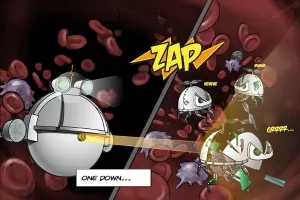‘Working for a greater good’

Part two of a three-part series on the 70th anniversary of the Master of Biomedical Communication program
In a world where everyone's cellphone is a gaming device, biomedical communication is having a huge impact on gamification. “Biomedical communications is special as a profession because you’re working for a greater good,” says Andrea Gauthier, who completed a master’s degree in the program and is now working on a PhD. “I studied commercial graphic design and illustration before this, and the difference is that here, you’re always trying to help someone with what you’re producing.”
Gauthier is researching how gamification might be used to engage people through puzzles and challenges. These challenges both inspire people to work harder to understand a concept, and also have the potential to leave a more lasting imprint.
“Most people think of gamification as something that is laid on top of traditional education programs—you complete an academic module and you get points or badges,” she says. “I’m working to integrate serious games and play more deeply into education.”
In Gauthier’s Vascular Invaders, for instance, rogue nanobots called Bacterbots have infected a university’s population, wreaking havoc on students’ immune systems. Players must travel through the blood stream, racing the heroic Bloodbot nanobot from invasion site to invasion site, to seek out and destroy these vascular invaders.
“I’ve played games all my life,” Gauthier says. “In my undergrad at UTM, I was a facilitated ideation coordinator. Me and a couple of other girls created a board game based on Cranium that would get people to think about Greek and Latin scientific terminology.” Games like Vascular Invaders incorporate traditional video gameplay, but success depends on internalizing the relevant medical knowledge.
Players have a limited amount of energy with which to reach the invasion site; traveling against the flow of blood uses up energy, so players must be strategic about the path that they take, and that means exercising their knowledge of vascular pathways in order to reach their goal.
Woolridge says Gauthier’s work takes the idea of “desirable difficulty” to a new level.
“There are some really interesting challenges ahead to figure out exactly where you deploy that difficulty,” he says. “A lot of what makes games motivational is that they frustrate you. But they frustrate you in a way that doesn’t make you want to give up, but makes you want to return to them.”
Read Part I of this series, "70 years of visual communications," here >
Read Part 3 of this series, "The origins of Grant's Atlas" here >



